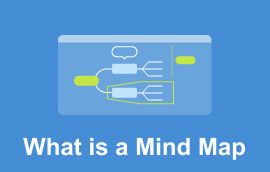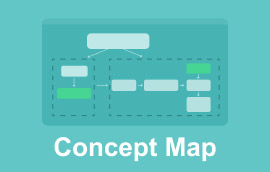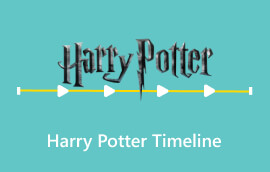Lengviausias būdas sukurti pasaulio istorijos laiko juostą
Pasaulio istorija yra didžiulis ir sudėtingas epas, apimantis ilgus metus nuo žmonių atsiradimo. Istorijos studijos gali pagerinti praeities supratimą ir pasisemti išminties bei pamokų, padedančių vadovauti dabarčiai ir informuoti ateitį.
Laiko juostos gali padėti išsiaiškinti pasaulio istorijos įvykius chronologine tvarka. Sekite mus ir sužinokite, kaip kurti pasaulio istorijos laiko juostos.

- 1 dalis. Kaip sukurti pasaulio istorijos laiko juostą
- 2 dalis. Pasaulio istorijos paaiškinimas
- 3 dalis. DUK
1 dalis. Kaip sukurti pasaulio istorijos laiko juostą
Norėdami visapusiškai suprasti pasaulio istoriją, turime sukurti pasaulio istorijos laiko juostą, kuri padėtų mums geriau pažinti istoriją. Kaip sukurti istorijos laiko juostą? Geriausias įrankis jums padėti yra „MindOnMap“.
MindOnMap yra galingas diagramų sudarymo įrankis, kurio tikslas – teikti vartotojams intuityvius ir lengvus minčių žemėlapius, o tai yra geras pasirinkimas kuriant pasaulio istorijos laiko juostas. Jį galima naudoti internete arba atsisiųsti „Windows“ ir „Mac“. Galime naudoti nemokamą jos versiją, kad sukurtume savo laiko juostas. Tuo pačiu metu sugeneruotas pasaulio istorijos laiko juostas galime nemokamai eksportuoti į JPG ir PNG formatus. Be to, platforma integruoja daugybę šablonų ir temų, o mes galime pasirinkti tinkamą šabloną arba tinkinti diagramos stilių ir išdėstymą, kad sukurtume laiko juostas.
Štai žingsniai, kaip sukurti pasaulio istorijos laiko juostą.
Eikite į oficialią svetainę MindOnMap. Spustelėkite Sukurti internete Norėdami pereiti į operacijos tinklalapį ir sukurti asmeninę paskyrą.
Pastaba
Taip pat galite pasirinkti Nemokamas atsisiuntimas mygtuką, kad įdiegtumėte jį savo kompiuteriuose.
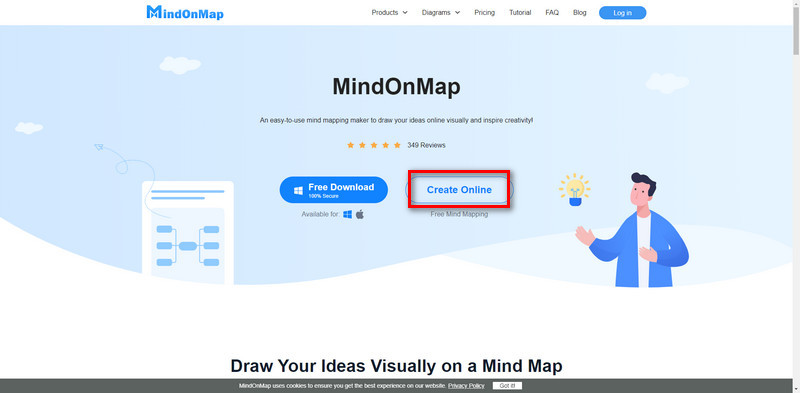
Spustelėkite Nauja kairėje meniu juostoje ir pasirinkite Dešinysis žemėlapis modelis, skirtas sukurti naują laiko juostą pasaulio istorijai paaiškinti.
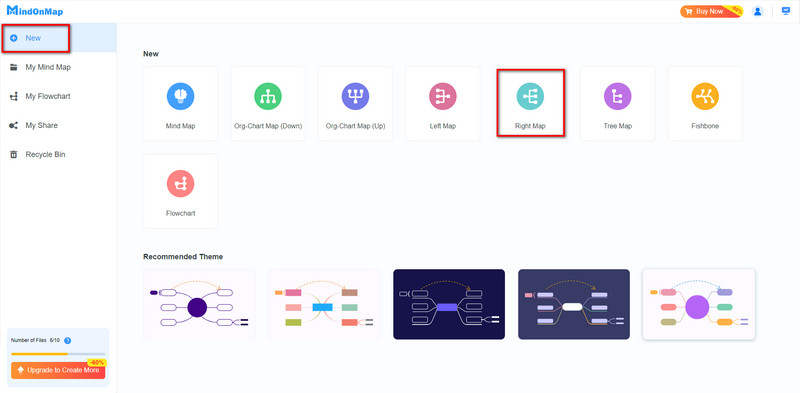
Dukart spustelėkite teksto laukelį, kad įvestumėte pasaulio istorijos laiko juostos pavadinimą.
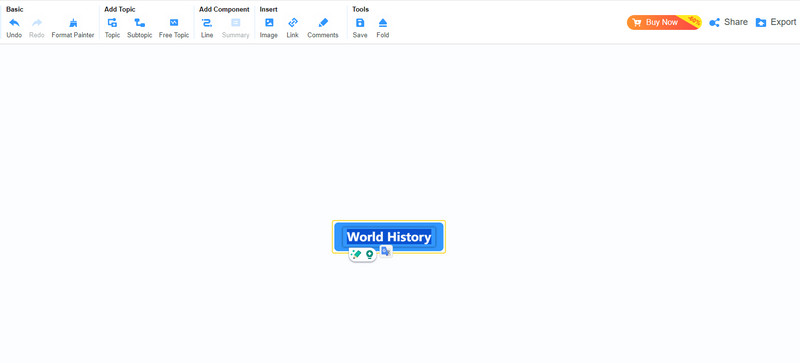
Pasirinkite teksto laukelį, prie kurio norime įtraukti potemą, ir spustelėkite Potemė įrankių juostoje.
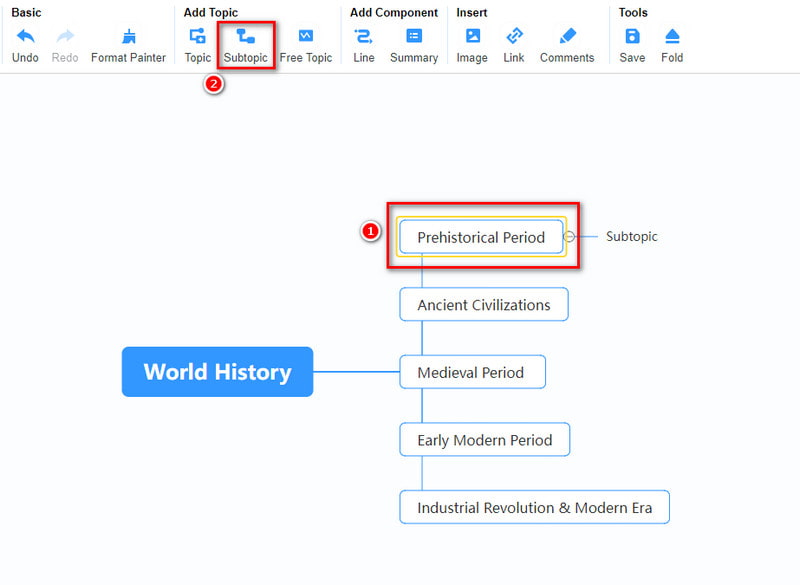
Pakartokite 4 veiksmą, kad pridėtumėte daugiau potemių ir įveskite daugiau informacijos apie pasaulio istoriją, kad užbaigtumėte laiko juostos turinį.
Kad pasaulio istorijos laiko juosta būtų ryškesnė, į laiko juostą galime įterpti vaizdus. Pirmiausia spustelėkite teksto laukelį, kuriame norime pridėti vaizdą, tada meniu juostoje spustelėkite Vaizdas ir Įterpti paveikslėlį išskleidžiamajame meniu, kurį norite pridėti.
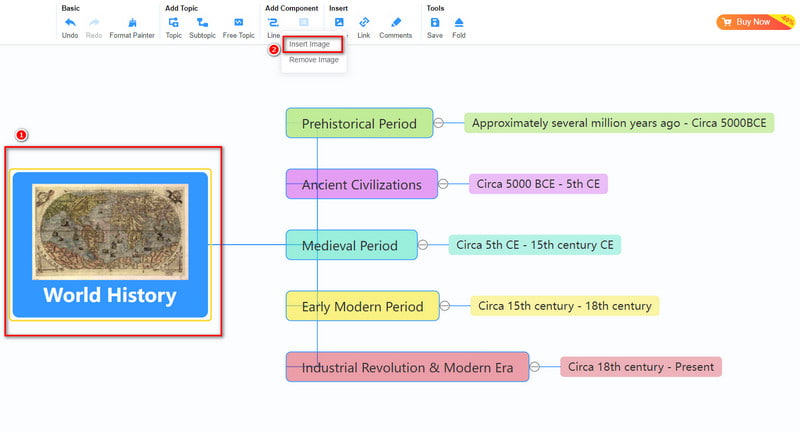
Eikite į dešinę įrankių juostą, kad tinkintumėte redagavimą. Spustelėkite Stilius nustatymas pakeisti teksto laukelio spalvas, kad būtų galima atskirti skirtingus pasaulio istorijos laikotarpius.
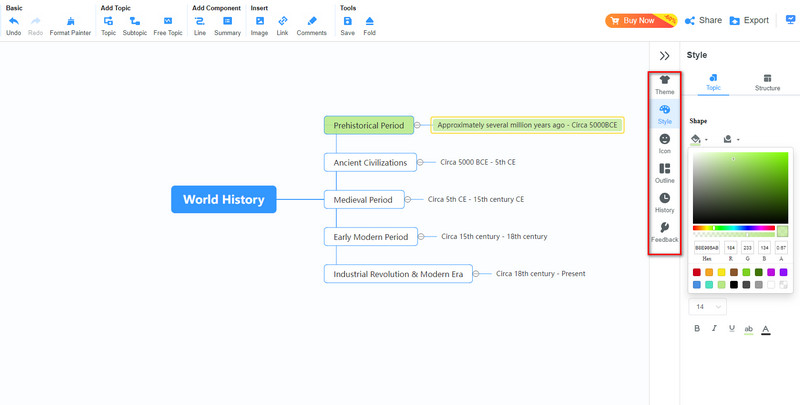
Viršutiniame kairiajame kampe pervardykite užbaigtą laiko juostą. Spustelėkite Dalintis dubliuoti pasaulio istorijos laiko juostos nuorodą arba Eksportuoti Norėdami nemokamai išsaugoti SD JPG arba PNG vaizdą su vandens ženklais.
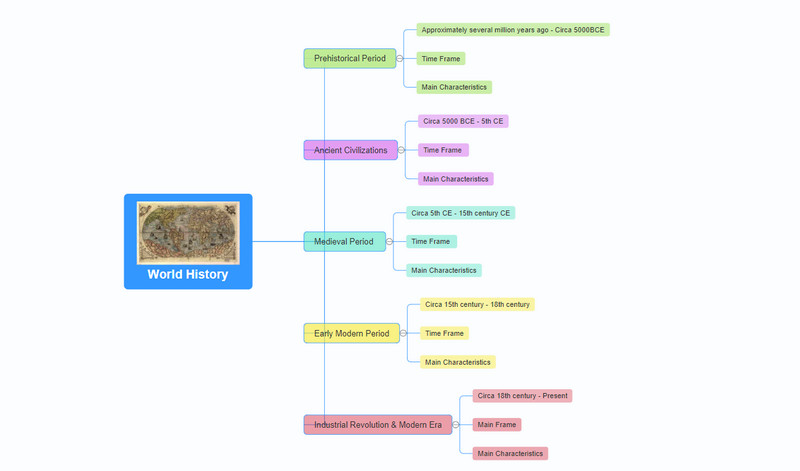
Pastaba
Be to, atnaujindami galite eksportuoti daugiau formatų, pvz., SVG failus, Word ir kt.
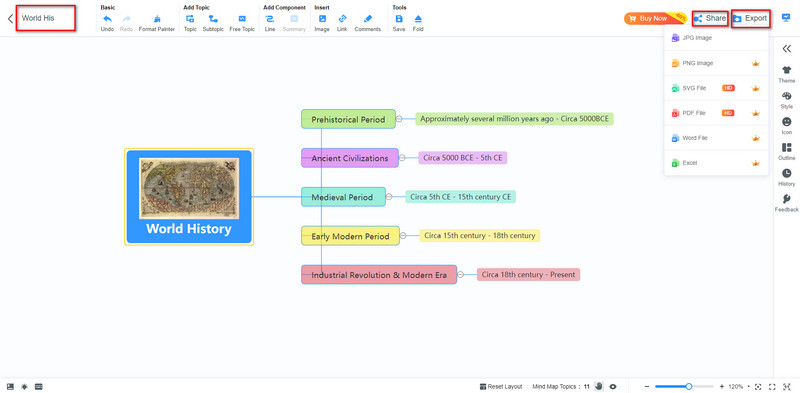
2 dalis. Pasaulio istorijos paaiškinimas
Pasaulio istorija yra ilga ir sudėtinga kelionė, kurią galima iš esmės suskirstyti į 5 laikotarpius, kurių kiekvienas pasižymi unikaliomis savybėmis ir reikšmingais įvykiais. Štai trumpas įvadas į pasaulio istoriją ir atitinkamus laiko tarpsnius:
I. Priešistorinis laikotarpis (maždaug prieš kelis milijonus metų – maždaug 5000 m. pr. m. e.)
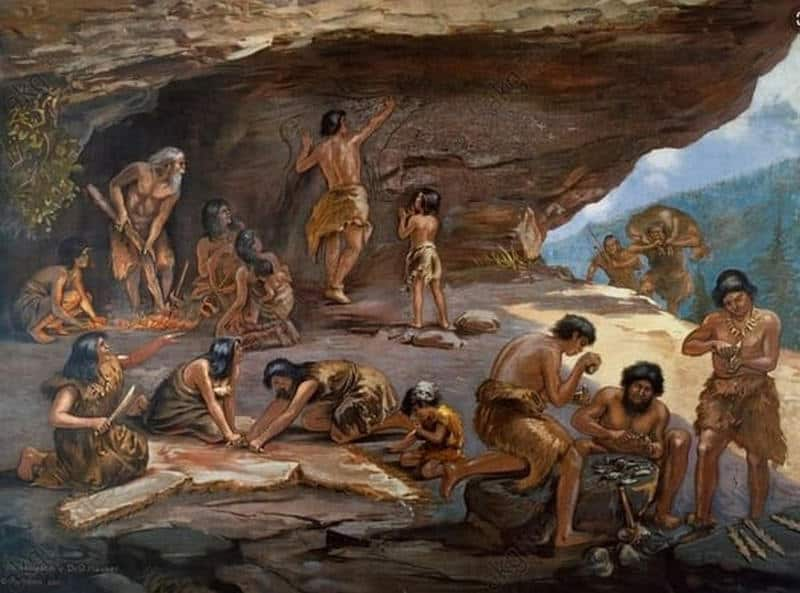
Laiko intervalas: Pradedant žmogaus kilme iki civilizacijos aušros.
Pagrindinės charakteristikos:
• Ankstyvoji žmogaus evoliucija: nuo Homo habilis, Homo erectus iki Homo sapiens.
• Primityvių visuomenių formavimasis: atsiranda genčių ir klanų organizacija.
• Pragyvenimo strategijos: medžioklė ir rinkimas, palaipsniui peraugantis į žemės ūkį ir gyvulininkystę.
II. Senovės civilizacijos (apie 5000 m. pr. m. e. – V a. e. m. e.)
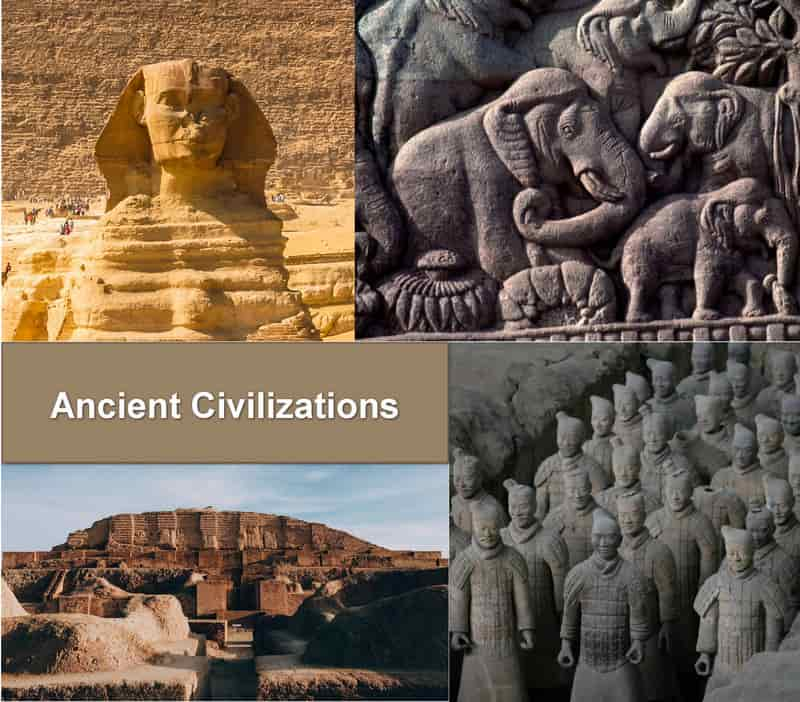
Laiko intervalas: Apima daugelio senovės civilizacijų iškilimą ir žlugimą.
Pagrindinės civilizacijos:
• Senovės Egipto civilizacija (apie 3100 m. pr. m. e. – 30 m. pr. Kr.): hieroglifai, piramidės, faraonų valdžia.
• Mesopotamijos civilizacija (Šumeras, Babilonas ir kt., apie 3500 m. pr. m. e. – 539 m. pr. m. e.): Kultūrinis raštas, Hamurabio kodas, Babilono kabantys sodai.
• Senovės Indijos civilizacija (Harappa, Mohendžodaro ir kt., apie 2600 m. pr. m. e. – 1750 m. pr. m. e.): miestų planavimas, prekybos tinklai.
• Senovės Graikijos civilizacija (apie 800 m. pr. m. e. – 146 m. pr. m. e.): Miestai valstybės, filosofija, teatras, olimpinės žaidynės.
• Senovės Romos civilizacija (Romos Respublika – Romos imperija, apie 509 m. pr. Kr. – 476 m. e. m. e. m.): Teisinė sistema, architektūros menas, krikščionybės plitimas.
III. Viduramžių laikotarpis (maždaug 5 a. m. e. – XV a. e. m.)
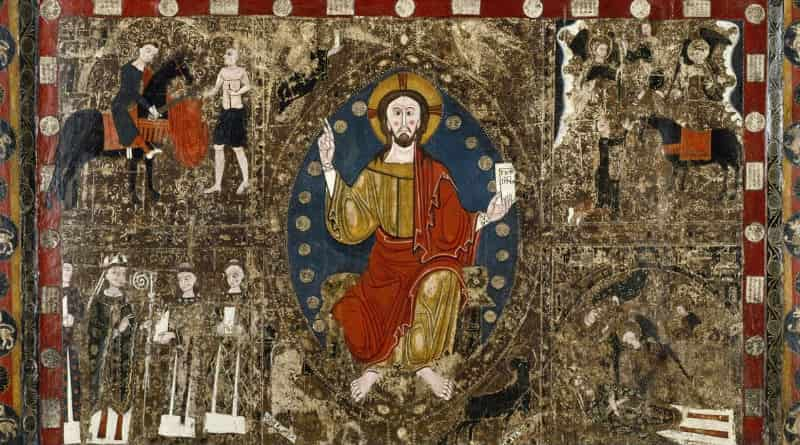
Laiko intervalas: Viduramžių laikotarpis yra feodalizmo formavimosi ir vystymosi Europoje era.
Pagrindinės charakteristikos:
• Feodalizmo įsigalėjimas: Ponų ir vasalų santykiai, dvarų ūkio iškilimas.
• Didelė krikščionybės įtaka: Bažnyčia tampa reikšminga politine jėga.
• Renesanso sėklos: atsinaujinęs susidomėjimas klasikine kultūra.
IV. Ankstyvasis naujasis laikotarpis (maždaug XV a. – XVIII a.)
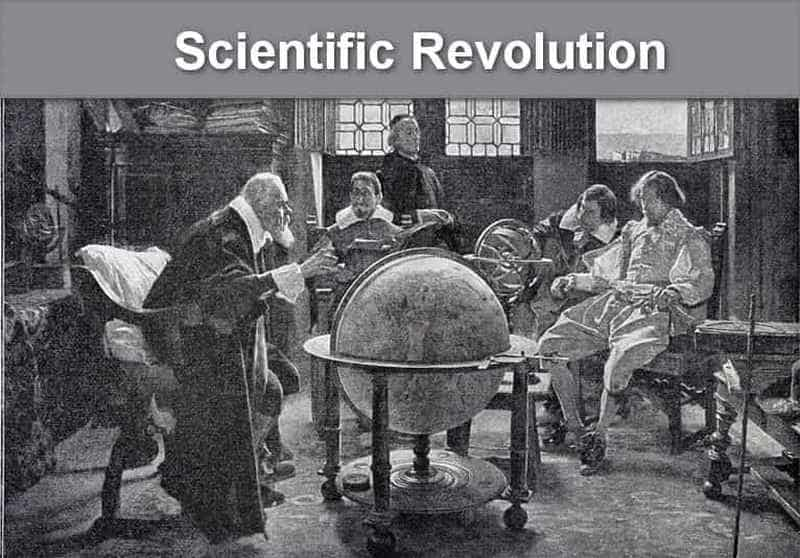
Laiko intervalas: Nuo Renesanso iki pramonės revoliucijos išvakarių.
Pagrindiniai įvykiai:
• Renesansas (XIV – XVII a.): klesti humanizmas, reikšmingi meno, mokslo ir filosofijos pasiekimai.
• Reformacija (XVI a.): vadovaujama Martyno Liuterio, meta iššūkį Katalikų bažnyčios autoritetui.
• Atradimų amžius (XV–XVI a.): tokie tyrinėtojai kaip Diasas, Da Gama ir Kolumbas atranda naujus pasaulius, sujungiančius pasaulį.
• Mokslo revoliucija (XVII a.): Niutonas ir kiti formuluoja tokias teorijas kaip visuotinės gravitacijos dėsnis, formuoja mokslinę metodiką.
V. Pramonės revoliucija ir modernioji era (maždaug XVIII a. – dabar)
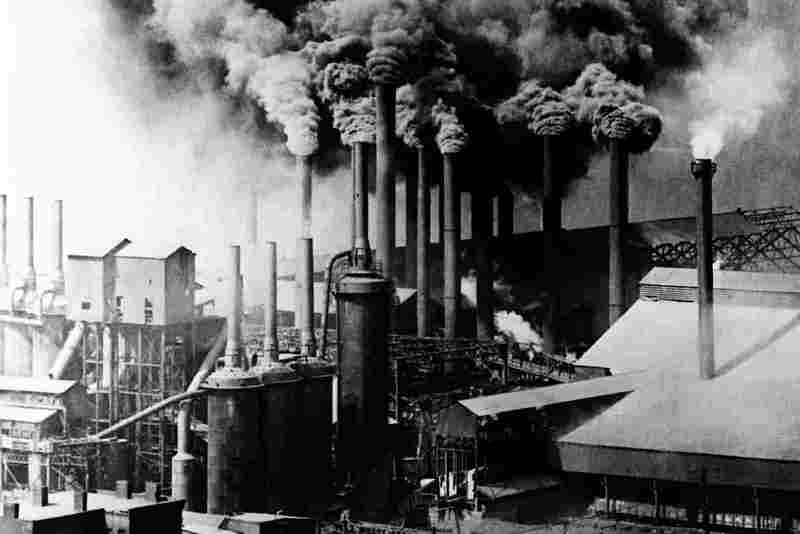
Laiko intervalas: Nuo pramonės revoliucijos iki šių dienų.
Pagrindinės charakteristikos:
• Pramonės revoliucija (1760 m. – XIX a. vidurys): plačiai naudojami garo varikliai, mašinų gamyba pakeičia rankų darbą, o produktyvumas auga.
• Politinės transformacijos: buržuazinės revoliucijos ir reformos, tokios kaip Prancūzijos revoliucija, Amerikos revoliucija ir Didžiosios Britanijos parlamentinė reforma.
• Technologijų pažanga: Antroji pramonės revoliucija (1870 m. – XX a. pradžia) pristato elektros ir vidaus degimo variklius; Trečioji pramonės revoliucija (1940 m. – dabartis) daugiausia dėmesio skiria informacinėms technologijoms, biotechnologijoms ir kt.
• Globalizacija. Tobulėjant transporto ir ryšių pažangai, pasaulis tampa vis labiau susijęs.
Pastaba
Dėl istorinių procesų sudėtingumo ir įvairovės aukščiau pateiktas skirstymas ir aprašymas gali turėti tam tikro subjektyvumo ir apribojimų.
Pažymėtina, kad laiko tarpsnių skirstymas nėra absoliutus, o istorikai, turintys skirtingą kultūrinį pagrindą, gali turėti skirtingus būdus. Be to, pasaulio istorijos raida yra nenutrūkstamas procesas, o įvairūs etapai nėra visiškai atskirti, bet turi tarpusavio persipynimą ir įtaką.
3 dalis. DUK
Kokie yra pagrindiniai pasaulio istoriniai įvykiai?
Yra daug svarbių istorinių įvykių, tokių kaip Amerikos revoliucija, pramonės revoliucija, Pirmasis pasaulinis karas, didžioji depresija, Antrasis pasaulinis karas ir kt.
Kada prasidėjo pasaulio istorija?
Rašytinė istorija prasidėjo Babilone, 3000 metų prieš Kristų. Istorinis pasakojimas prasidėjo maždaug 2000 metų prieš Kristų.
Koks yra pats istoriškiausias momentas istorijoje?
Ugnies naudojimas, kalbos išradimas, įrankių ir metalurgijos kūrimas, mokslo revoliucija ir dukart įvykusi pramonės revoliucija
Išvada
Šiandien pristatome kaip sukurti pasaulio istorijos laiko juostą su galingu įrankiu MindOnMap. Laiko juosta yra naudinga forma, padedanti mums geriau suprasti temą. Norėdami sužinoti daugiau apie pasaulio istoriją, MindOnMap bus geriausias pasirinkimas šukuoti didelius įvykius ir išsiaiškinti esmę.
Ar kada nors išmokote sudaryti laiko juostą? Jei turite problemų, pakomentuokite mus ir mes atsakysime laiku.


Sukurkite savo minčių žemėlapį, kaip jums patinka







